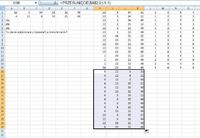Hello,
I need help, I can't write a macro in Excel 2013 that generates all combinations of 4 numbers from a given set of specific 6 numbers, i.e.:
Input data:
In the lines (cells A1,B1,C1,D1,E1,F1) there is a set of random numbers from the range 1-49 (LOTTO draw result); I want to generate all combinations from this set without repetitions, 4 numbers per line, e.g. A1,B1 ,D1,F1 etc. and the result appeared in columns e.g. H1,I1,J1,K1, H2,I2,J2,K2 until the combinations were exhausted.
After generating, I want the macro to deal with the next set of numbers from row A2,B2,C2,D2,E2,F2 and again add the results as a continuation in column H,I,J,K and so on until all systems from column A,B are exhausted, C,D,E and F
Does anyone know how to write such a macro? What should it look like?
Thanks for the help.
Regards,
I need help, I can't write a macro in Excel 2013 that generates all combinations of 4 numbers from a given set of specific 6 numbers, i.e.:
Input data:
In the lines (cells A1,B1,C1,D1,E1,F1) there is a set of random numbers from the range 1-49 (LOTTO draw result); I want to generate all combinations from this set without repetitions, 4 numbers per line, e.g. A1,B1 ,D1,F1 etc. and the result appeared in columns e.g. H1,I1,J1,K1, H2,I2,J2,K2 until the combinations were exhausted.
After generating, I want the macro to deal with the next set of numbers from row A2,B2,C2,D2,E2,F2 and again add the results as a continuation in column H,I,J,K and so on until all systems from column A,B are exhausted, C,D,E and F
Does anyone know how to write such a macro? What should it look like?
Thanks for the help.
Regards,




